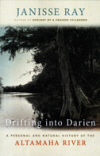Drifting into Darien
Drifting into Darien, part memoir and part natural history, logs the memory of not only the people of the Altamaha River region in Georgia, but the landscape itself. In a multi-part larger essay and a series of smaller essays, Janisse Ray reminds us of this essential but little-known river. Readers who already possess knowledge of ecology and biology, as well as novice environmentalists, will appreciate the detail displayed by Ray’s knowledge of her native landscape. A strong environmental focus propels this collection of essays forward, urging the reader to take action to preserve not only the Altamaha, but their own rivers as well.
Drifting into Darien, part memoir and part natural history, logs the memory of not only the people of the Altamaha River region in Georgia, but the landscape itself. In a multi-part larger essay and a series of smaller essays, Janisse Ray reminds us of this essential but little-known river. Readers who already possess knowledge of ecology and biology, as well as novice environmentalists, will appreciate the detail displayed by Ray’s knowledge of her native landscape. A strong environmental focus propels this collection of essays forward, urging the reader to take action to preserve not only the Altamaha, but their own rivers as well.
Divided into two sections, the collection opens with an eight-part essay titled “Total Immersion: A Week on the Altamaha River.” Each of the parts retells a day of the kayaking trip Ray and her husband took along the Altamaha. In rich detail, Ray describes the flora and fauna she observes during her trip. On “The First Day,” Ray sees “a swallow-tailed kite swoop[ing] low over the trees. It appears from the port side of the floodplain and pirouettes in yellow sunlight. If you’ve never seen a swallow-tailed kite, you must go as soon as possible to find one.” Ray continues these direct addresses, in encouraging and enthusiastic tones, urging the reader to spend time outside in the natural world.
A series of smaller essays, divided into chapters, complete the remainder of the collection. Ray intersperses lyrical descriptions of the landscape with scientific language and practical information. For example, in “Endangered Landscape,” she chronicles The Nature Conservancy’s efforts to preserve and protect the Altamaha. Ray reminds the reader that “the Altamaha supports…the largest documented aggregation of globally imperiled elements of any watershed in Georgia.” For her, the message is clear: protect the river and the watershed.
This message constantly becomes reinforced through essays addressing other aspects of the river, such as in “Stewards of the Mysteries of God.” Ever aware of the reader’s presence, Ray prefaces the story of a fisherman who became the first Riverkeeper of the Altamaha with: “This story is one of the transformations that is possible when one wakes up to the beauty and wonder of the earth, if one fears not, if one follows the path of his or her heart. The story of the transformation is possible if people join together and decide to protect something they love. With love, many things are possible.” The narrative demonstrates how anyone can become involved in saving beloved places.
While some essays may overlap in content, their message remains clear: in order to save what you love, you must constantly broaden your intellectual horizons through research, personal experience, and passion. This collection illuminates the consequences of human destruction and ignorance of the landscape, and the book itself provides a source of enlightenment.





